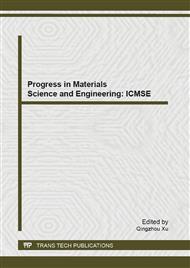p.457
p.465
p.469
p.473
p.478
p.484
p.490
p.496
p.501
Flame Retardancy of Polypropelene/LDHs Composites: An Influence of Organo-LDH Types
Abstract:
Organic-LDHs was prepared by three methods including co-precipitation, ionexchange and roast reduction process using Lauryl alcohol phosphoric acid ester potassium (MAPK) asmodifier.Polypropylene (PP)/Organically-modified layered double hydroxides (LDH) was prepared by the melt blending method. The structures and morphologies of composites were characterized by X-ray diffraction and TEM. TGA, cone calorimeter, limiting oxygen index (LOI) and the UL94 protocol were used to characterize the thermal stability and fire properties of composites. The results indicate that MAPK was successfully intercalated into the interlayer of LDHs and MAPK has a different arrangement in the interlayer of organicLDHs for different preparation methods of LDHs. PP/ionexchangeorganicLDHs (PP/ion-o-LDHs) and PP/roast reductionorganicLDHs (PP/ro-o-LDHs) show a better dispersion of LDH in PP than PP/co-precipitationorganicLDHs (PP/co-o-LDHs) composites. Compared to pristine PP, the peak heat release rate of PP/10% co-o-LDHs, PP/10% ion-o-LDHs and PP/10% ro-o-LDHs decreased by 21%, 33% and 30% respectively. The limiting oxygen index increased by 3.7 from 17.2(in PP) to 20.9(in PP/10% ion-o-LDHs). All of the composites could obtain an HB in the UL-94 horizontal burning.
Info:
Periodical:
Pages:
478-483
Citation:
Online since:
October 2013
Authors:
Keywords:
Price:
Сopyright:
© 2013 Trans Tech Publications Ltd. All Rights Reserved
Share:
Citation:


